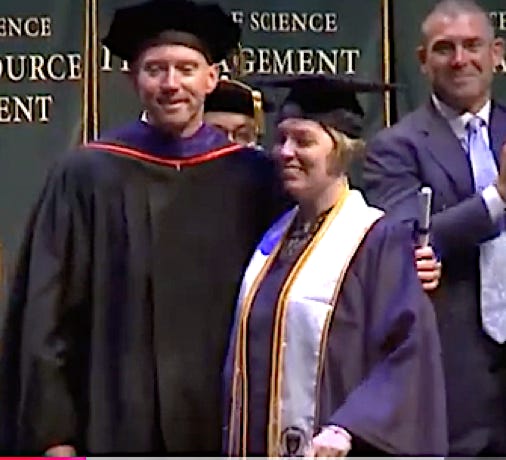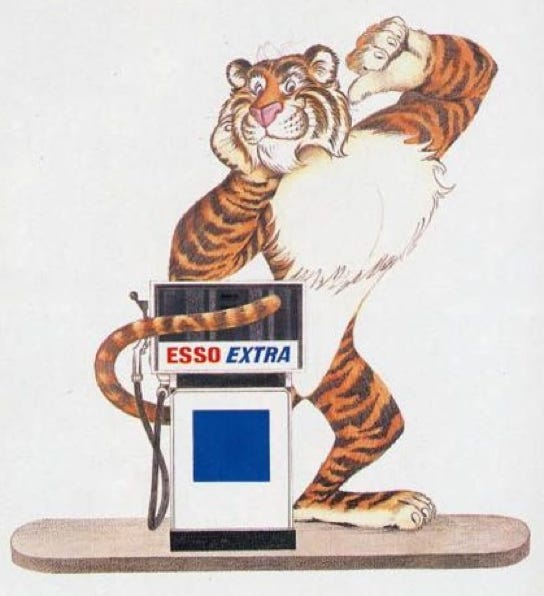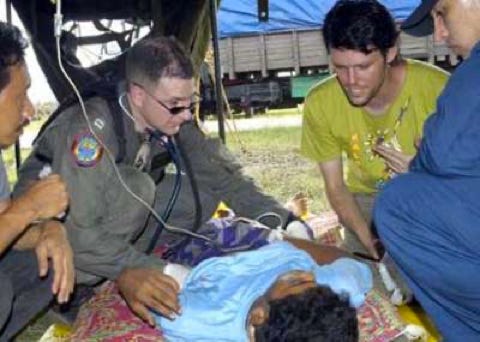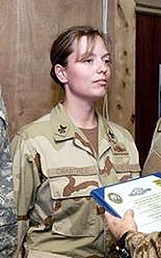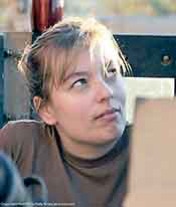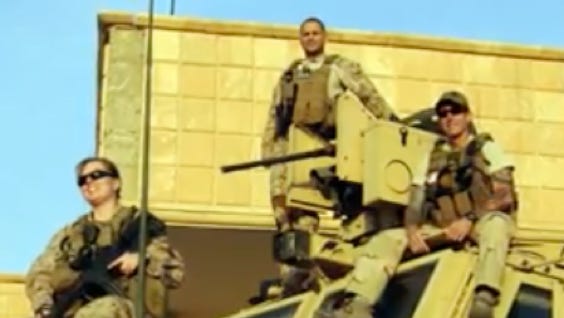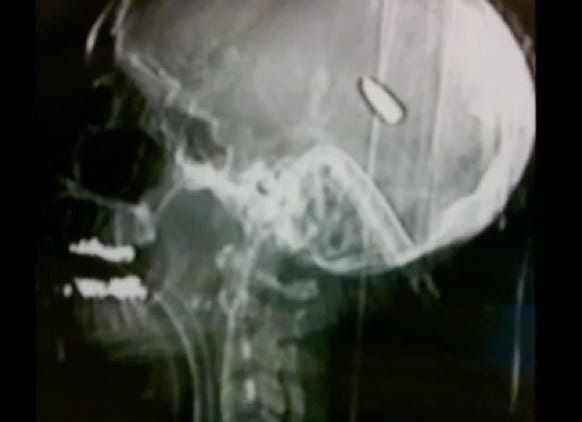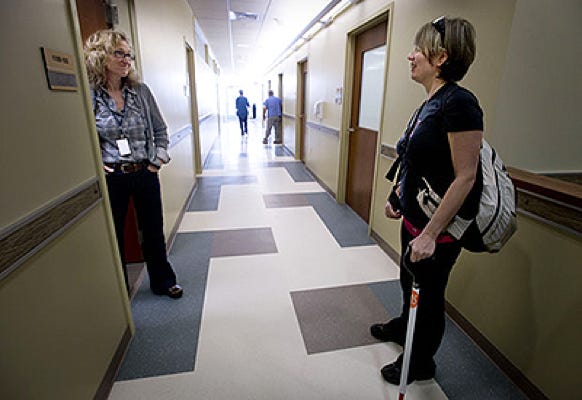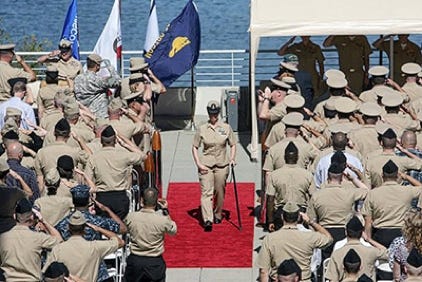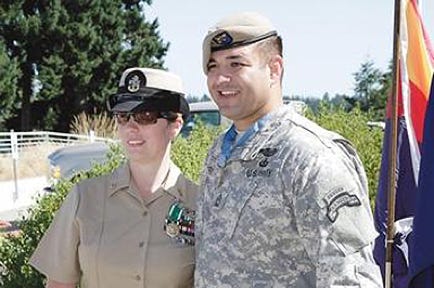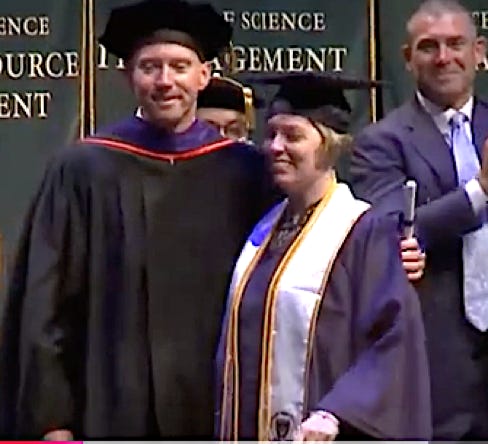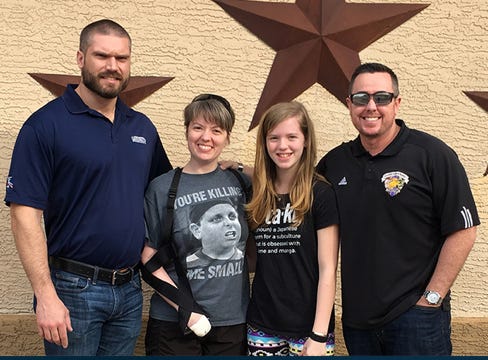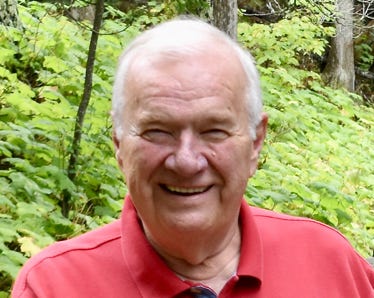DUTY, HONOR, COURAGE, RESILIANCE
Talking Proud: Service & Sacrifice
Corpsman down! A fight for life
“Hope can mean anything you want it to mean”
Her name is Holly Anne Katke, Hospital Corpsman Chief Petty Officer, USN (Ret.)
Remember the old Esso commercials about putting a “Tiger in your tank?” Well, this woman has a tiger in her tank, to be sure.
She played three sports in high school, aptly named the Port Angeles High School “Roughriders.” She was said to be “an athletic, rambunctious young woman.” In her senior year, she enlisted in the Navy in the delayed entry program and took community college courses that same year to become a licensed practical nurse.
After graduation in 1998, she went to the Navy’s “boot camp” at Great Lakes, then to basic hospital corpsman school. The Navy sent her to its Naval Health Clinic at Cherry Point, North Carolina, and then, in 2001, to more medical training in Portsmouth, Virginia.
By 2004, she was aboard the USS Abraham Lincoln (CVN 72). For eleven months, the Abe underwent maintenance, repairs, and upgrades at Puget Sound Naval Base near her home in Seattle.
This Navy photo shows Hospital Corpsman 2nd Class Holly Katke conducting an inventory of a mass casualty first aid box in the hangar bay aboard the Abe. At the time, Lincoln was conducting training exercises in preparation for a scheduled deployment.
My educated guess is that she married in the summer of 2004 while still in port and took the name Holly Crabtree. The Abe was then deployed to the Western Pacific in October 2004. There, she and many others supported the victims of an Indian Ocean megathrust earthquake measured at 9.1 and a tsunami in and around the epicenter in Aceh, Indonesia.
I’ll pause for a moment to address this earthquake and the USN/USMC/USAF response, known as Operation Unified Assistance. The USN Lincoln Carrier Strike Group, the USS Bonhomme Richard Expeditionary Strike Group, the USN Mercy Hospital Ship, and USAF transports all came to the area to help. More than 12,000 Americans were involved.
I collected photos of this response and was stunned by the devastation and bolted with pride at how our military people got in there to help as best they could. An estimated 230,000 people were killed, tens of thousands more injured, and nearly two million became homeless and displaced.
The situation confronting everyone was overwhelming, in my book, daunting.
The Abe returned to Puget Sound in March 2005.
Crabtree served with the USNS Mercy Hospital Ship detachment in San Diego from 2004 through 2007. I believe her daughter, Leah Crabtree, was born in 2006. I highlight Leah because, as a young girl, she would become Holly's linchpin, which would be a huge challenge for young Leah. Holly would later say,
“The most important part of my life is my daughter … I will go to Earth and the moon and back for my daughter.”
Corpsman Crabtree was selected to attend the Navy's Independent Duty Corps (IDC) School in San Diego. This 12-month school is designed for highly motivated hospital corpsmen. It trains corpsmen in pay grades E-5 through E-7 to work with special operations teams. Earning this education qualified her for various jobs, one of which was with Special Warfare units.
This photo of Petty Officer-1 (PO1) Crabtree (pay-grade E-6) was taken when she received the Expeditionary Warfare (EXW) qualification certificate from the Navy SEALs. She graduated in November 2008. She was now at the top of the heap in hospital corpsmen training and was qualified to serve with the SEALs. Once students graduate from this 12-month course, they are considered "The Best of US Navy Medicine." As a graduate, she earned one of the most respected Naval Enlisted Classifications in the Medical Enlisted Community.
She then went to the Marine Corps Recruiting Depot at Parris Island, South Carolina. In 2009, she shipped off to Ramadi, Anbar Province, Iraq, to provide medical support to special forces operating there.
By 2009-2010, the US was winding down its combat operations in Iraq, and Iraq was preparing for elections. In March 2010, parliamentary elections were held. However, insurgents vowed to disrupt the elections.
Problems with the insurgency were felt in Ramadi. Coordinated bombings struck the city in late December 2009, leaving 20 dead and 60 injured. Despite US efforts, Ramadi remained unstable and one of the most violent areas of Iraq.
Tom Peter wrote this for the Christian Science Monitor,
“In recent months, Iraq has seen an uptick in high-profile attacks reminiscent of the bloodiest days of the conflict. Many analysts attribute the rise to militant groups trying to destabilize the country prior to the March elections.”
In February 2010, a suicide bomber struck a heavily fortified compound in Ramadi, killing thirteen and wounding more than 20.
While on patrol in the Ramadi area on April 10, 2010, Corpsman Crabtree was hit in the head by a sniper’s bullet.
This photo shows her in Iraq before a mission. The Peninsula Daily News reported that it was taken just before she went on the mission in which she was wounded.
She was aware of the dangers. She has remarked,
“When we walked into a village, they would know I was medical because I had the big pack."
Crabtree commented on her role,
“The women in other countries, they can’t speak to other men. They can only respond to females. Those women would come to me with medical needs. I would therefore have to say tell me the information you have, and then I will assess your needs. Because no one was there to do it medically but me.”
The idea of deploying women with special forces developed early in Iraq and then spread to Afghanistan. When a team entered a village, the men were mostly confined to talking to men in the village to collect information and befriend them. Adding women enabled them to establish contact with women, who could number more than half of the village. Such contact would improve US military relations with the villagers and uncover a great source of intelligence.
She was selected for this role in part because she was fluent in Arabic. This was to be her last mission.
Her commander told her the night before that the enemy knew about her because few women could do what she was doing. Cecilla Chan reported for the Tempe Tribune, “Katke (her name before marriage) was told she was going to be sent stateside and that in the meantime she should stay behind the wire, where she would be safer.” Chan reported Holly’s reaction,
“The way I looked at it, is the guys going out tomorrow. I said, ‘What’s the difference if a female goes out. The guys are targets. What makes me any different?’”
She knew she could be an enemy target. Her commander knew it. And on April 15, 2010, she was the target. She has said,
“What I do remember is we went out, we were in a police station, I was just walking around trying to hydrate, and all of a sudden I was out.”
By “out,” she was down for the count. A sniper’s bullet struck her in the head. The bullet pierced her helmet near her left temple, entered her skull, and came to rest behind the ear. She said she remembered being hit and said later,
"The first thing I remember after I woke up is that I was still in the Humvee. I was embarrassed. I thought I passed out from the heat. I pushed myself up and I noticed all this blood going down my arm.”
Arwyn Rice, reporting for the Peninsula Daily News & Sequim Gazette, said she said that the bullet hit the left side of her head and lodged behind her left eye.
She was evacuated right away to a field hospital. She endured a six-hour surgical operation and was not expected to live through it. VA News reported, “The bullet’s path was only an eighth of an inch from being fatal.” Sarah Farrell quoted Holly saying,
“The bullet, it stopped between my temporal and parietal lobe.”
Incredibly, she survived and was stabilized. She was then evacuated from Iraq to Bethesda Naval Hospital, Maryland.
So, what does a young “athletic, rambunctious young woman” who rose to the top of her enlisted medical profession do? Holly Katke now had to deal with traumatic brain injury, a life-altering experience.
In a video of her following this mind-numbing experience, she said,
“Hope can mean anything you want it to mean.”
Holly has been described as a “go-getter,” an enterprising, highly motivated woman. She has shown herself to be persistent, driven, and equipped to see things through. She no doubt had to call on these traits after being shot and after surviving the surgery. Now, she faced even more significant challenges: recovery, caring for her daughter, Leah, and living her life.
It took her about three months in the hospital before she became fully aware of what was going on around her. Initially, she did not even know she had a daughter, Leah. But she began recovering. That said, she had paralysis on the right side and suffered a traumatic brain injury, which affected her memory, speech, and motor skills.
Sarah Farrell reported,
“The injury has left Katke with partial blindness, aphasia and paralysis on the right side of her body. Aphasia usually occurs after a stroke or brain injury.”
Aphasia has to do with losing the ability to understand or express speech.
“In my mind I know what I want to say, but the words aren’t exactly coming out of my mouth. Because the bullet, it stopped between my temporal and parietal lobe.”
Farrell reported, “The bullet remained in her brain for three months before the swelling went down, and doctors were able to remove it.” I get a chill just thinking about that surgery and the period during which she had to wait for the swelling to subside.
Holly said,
"Things were tough for a couple of years." She added, "I wanted to snap my fingers and get better. I was going through depression so bad as well as trying to get better so hard I was hurting myself … I stopped eating. I wasn't hungry. The only thing that kept me going was my daughter, Leah."
I found an article published by EpilepsyU.com, which said Holly had been having seizures every week or two since she was shot. Crabtree commented, "They surprise me," meaning she could not tell they were coming. She reportedly had had two strokes, partial paralysis, and epilepsy. The photo shows Crabtree leaving a session with a psychologist at the VA hospital in Seattle.
The VA hospital in Seattle helped her, but it was stressful to drive three hours to the hospital, receive treatment, and then drive back.
She was transferred back to her unit's home base at MacDill AFB, Florida, for physical rehabilitation at the James A. Haley Veteran's Hospital and her ultimate discharge from the Navy. She received her fourth Navy Commendation Medal here for her avid “can-do " support of other critically wounded military members.
Frank Smith, a neurology nurse coordinator at the Haley VA, said,
“Overall, she is managing well and she is where we would expect her to be … She is somebody that is very driven, very focused and family-oriented, and I think she is going to have a great outcome.”
Holly’s sister, Sarah Whatley, a first-class sergeant in the Army, shown on the left of this photo, managed to stay with Holly for four months before returning to Army duty.
From news reports, Holly Katke was disappointed that the Navy required her to retire. She had only served 14 years and was now 32 years old. She said, “I wanted to stay.”
Ed Friedrich, writing for the Kitsap Sun, quoted her saying,
“I can still move my hand. I can still walk a little bit. I'm still good. I can do something.”
Friedrich said she “grudgingly accepted medical retirement.” That said, she seemed to understand,
"You know what, I can keep on going, do it one more time.”
In short, Holly Katke knew she had to press on. Press on she did. Her first stop was transferring to Naval Hospital Bremerton in the summer of 2010. Friedrich reported,
“She got a hero's welcome June 10 (2010) at Seattle-Tacoma International Airport. It included a large crowd of greeters and firetrucks spraying water across the plane's nose.”
The next stop was to be her retirement ceremony. Holly Katke might be retiring from the Navy, but she was not yet done with the Navy.
The Navy intended to retire her as Petty Officer First Class. But hold your horses, US Navy. She studied Navy regulations and found that she could take the chief petty officer (CPO) exam. She had problems reading it, so a CPO read the questions to her. She answered the questions, passed the test, and was promoted to Chief Hospital Corpsman in 2011. That meant, among other things, the Navy would retire her as a CPO instead of the lower-ranking PO1. That's a huge boost for a tough woman, a woman who had a daughter Leah to raise.
She retired from the Navy in 2012. At the time, she walked with a cane, was legally blind, and had difficulty with her memory.
It was this photo that attracted me to her story. It looked like a grand ceremony. What caught my eye, however, was the man in the front row, saluting and wearing camouflage fatigues and a tan beret, certainly not a Navy guy. It turned out he was Sergeant First Class (SFC) Leroy Petry, who, among other things, had received the Medal of Honor. I then noticed he had a prosthetic arm, the result of his losing his right arm below the elbow in combat in Afghanistan.
Why was he there? He was stationed in nearby Tacoma. He said,
"I got word of it (the retirement ceremony) and said it would be my honor to be there."
Petry apparently made an impression on Holly. At the time, Petry worked with injured veterans in Tacoma. She commented, “I want to do what he does."
Holly participated in the 2011 Wounded Warrior Games held in May 2011 in Colorado Springs. She was among 32 Navy and three Coast Guard members selected to represent the 2011 Navy/Coast Guard team. She was selected while at Naval Hospital Jacksonville. This photo shows Crabtree shooting an AR-15 as part of the Combat Wounded Veteran Challenge. She reportedly hit the target in a tight grouping, the first time she had fired the weapon since she was wounded.
In 2012, she went with a group of other combat-wounded veterans to a remote river in Alaska on what's known as the Combat Wounded Veteran Challenge, designed for those with post-traumatic stress disorder (PTSD). It was a pack-rafting challenge. She went on the trip just two weeks after being released from the trauma center at the Haley VA hospital. She carried a heavy pack on her back, slid down a rocky hill on purpose, and adapted to two weeks of the rigors of the wilderness. She walked, tripped, fell, slept on rocky ground, and experienced being drenched by rain. In this photo, she is climbing up a "hill." I'm not sure which one she is, but I think she is number three in line. She worked with her team to navigate and row a raft on a cold and swift river, using her left arm to row. Oh yes, the mountains were still covered with snow!
Following this rafting trip, she said:
"I was at the point where I'd given up hope. I was doing that because I'd locked myself in a box. I took a chance and went on this trip and it turned out to be the most awesome and therapeutic thing I could ever walk into. I don't even feel like the same person," she says. "So I encourage anyone and everyone to take the step outside that box and try something. Now that I have that faith in myself, it's like there are countless people I can have that faith for."
Holly discovered a love of sailing and used the sport as part of her recovery.
Each year, the organization Hope for the Warriors® presents awards to honor the courage of wounded service members, their families, and the families of the fallen. The organization was founded in 2006 by a group of military wives. The award is known as the Vigiano Family Hope & Courage Awards, given to service members and military families who have demonstrated hope and courage in facing challenges after their injuries. It is named in honor of the two Vigiano sons, NYPD Detective Joseph Vigiano and FDNY fireman John Vigiano II, who were killed as a result of the September 11 attacks in New York. Their father, John Vigiano, Sr. is a former Marine and retired FDNY Captain who has volunteered his time and resources to help Gold Star families and wounded heroes. He is on the honorary council of the Hope for Warriors.
Holly received this award in 2012. This photo shows CPO Crabtree with her daughter Leah receiving the award with actor Gary Sinise, who serves on the Hope for the Warriors Advisory Council. Please note the Expeditionary Warfare pin above CPO Crabtree's medals.
Holly took online classes through Trident University International and worked toward a bachelor's degree in environmental health. Sarah Farrell, writing “Heart of a Warrior: Holly Katke,” has said while pursuing this degree, she worked at Mote Marine Laboratory and Aquarium in Key West as part of the Combat Wounded Veteran Challenge for coral restoration efforts. Mote does advance marine research worldwide.
She received her degree in 2016, finished her internship at Mote, completed her Master of Science in Health Sciences and Public Health with Trident, and continued volunteering with Mote.
Katke heaps a lot of praise on Trident, saying,
“The teachers were absolutely wonderful in helping me, you know, my daughter was with me, everyone knew school was very important to me … How do I feel this degree is going to improve my life is the fact that I show myself and all the other veterans who are in the hospital or they’re out of the hospital that even though I was injured, I couldn’t read, I couldn't write, but there’s still a way for us and actually go to college and succeed at it and move on.”
In 2018, the Carrington House Charitable Foundation (CCF) provided Holly and her daughter with a one-story renovated house in Gilbert, Arizona. Commenting on this home, Katke said,
“Moving into a fully ADA-compliant home will allow me to function much more efficiently and become more independent, as well as help me in raising my pre-teenage daughter. With continued training, and knowing that I have an ADA home, I feel confident I can do better … (CCF) is a lifesaver for my daughter and me. The generosity and how they make you feel like part of the Carrington family is truly remarkable. We now have a new family to share our life with.”
Holly Katke was scheduled to participate in the Warrior Games in San Antonio in 2020, but they were canceled due to the pandemic. The city will host the games in 2026 and 2028.
CPO Holly Katke is one helluva woman, one helluva Sailor, one helluv-an American, and, by all indications, a fabulous medic and mother. She has paid heavy dues for her service. As she has said:
“I don't regret anything that happened. I love the Navy. I love my job … This is our job.”
Sarah Farrell, writing “A Journey from the Battlefield to the Playing Field,” said this of her,
“We often try to put people in a box. Attach labels to them to try and define who they are.
‘Veteran. Mom. Researcher. College Graduate. Athlete. True, Holly Katke is all of these things, but none define her. She doesn’t fit in any one box. She transcends them.
“The one common thread throughout her life though has been her passion to serve those around her.”
Click to zoom graphic-photo
